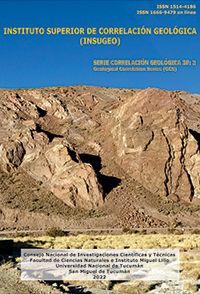Serie Correlación Geológica 38 (2)
Análisis de georrecursos culturales para el uso turístico. Aplicación de una propuesta metodológica en el norte de Tierra del Fuego (Argentina)
Soledad Schwarz | Sabrina Labrone | Andrea Coronato | Flavia Flores Barrera | Grisel Guerrero Gallardo | Mónica Salemme
Descargar trabajo en formato PDFResumen
El norte de Tierra del Fuego (Argentina) cuenta con una interesante historia geológica y geomorfológica pero también cultural; se trata de un espacio geográfico que ha sido habitado por grupos de cazadores-recolectores pedestres desde al menos 6000 años. Desde la segunda mitad del siglo XIX, la instalación del hombre blanco generó también evidencias aún hoy visibles en el paisaje, además de los numerosos documentos escritos generados por diversos exploradores. Debido a su relevante geodiversidad con contenido cultural, este entorno resulta un escenario susceptible de uso turístico-recreativo. Para ello, se propone el concepto de georrecurso cultural (GC), es decir, aquel elemento de origen geológico y/o geomorfológico que posee algún tipo de registro arqueológico y/o histórico. En este marco, la presente contribución tiene por objetivos presentar una metodología para el análisis de GC para el uso turístico y mostrar su aplicación en el norte de Tierra del Fuego. La propuesta metodológica implica distintas etapas, con trabajo de campo y de gabinete. A partir de la revisión bibliográfica, se diseñaron dos instrumentos de recolección de datos: una ficha descriptiva y una matriz paramétrica basada en tres ejes de análisis: geológico-geomorfológico, arqueológico-histórico y turístico-recreativo. La aplicación de ambos instrumentos permitió jerarquizar los GC y aprovechar su potencialidad didáctica mediante la divulgación de diversas disciplinas científicas.
Abstract
ASSESSMENT OF CULTURAL GEORESOURCES FOR TOURIST USE. APPLYING A METHODOLOGY IN NORTHERN TIERRA DEL FUEGO (ARGENTINA). The North of Tierra del Fuego (Argentina) has an interesting geological and geomorphological history but also cultural; it is a geographical space that has been inhabited by groups of pedestrian hunter-gatherers for at least 6,000 years. Since the second half of the 19th century, the settlement of the white man also generated evidence that is still visible today in the landscape, in addition to the numerous written documents left by various explorers. Due to its relevant geodiversity and cultural content, this environment is a susceptible scenario to tourist-recreational use. In this sense, the concept of cultural georesource (GC) is proposed as an element of geological and/or geomorphological origin that has some type of archaeological and/or historical record associated. In this framework, the present contribution aims to present a methodology for the analysis of GC for tourist use as well as to show its application in Northern Tierra del Fuego. The methodological proposal involves different stages through field and office work. Based on bibliographic review, two data collection instruments were designed: a descriptive chart and a parametric matrix based on three axes of analysis which are geological-geomorphological, archaeological-historical, and tourist-recreational. The application of both instruments allowed us to rank the GC taking advantage of their didactic potential through the dissemination of various scientific disciplines.






